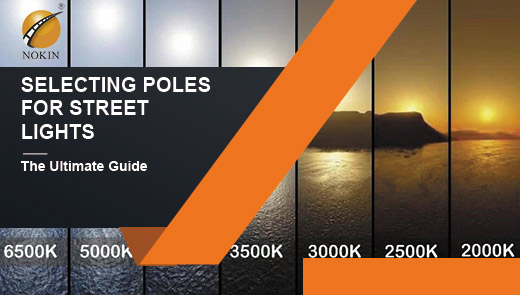How Many Lumens Do I Need for Outdoor Lighting
The importance of outdoor lighting cannot be underestimated. It can transform a monotonous, boring backyard into a vibrant gathering place; it can also provide your home with extra security at night. And when planning outdoor lighting, a key question surfaces: how many lumens of light do you really need? The unit of lumens plays a pivotal role in determining the effectiveness of outdoor lighting, so let's delve deeper into this topic.
What are lumens? Why is it so important?
In the past, light was measured in watts, which directly reflected the amount of electrical power consumed by a light bulb. As a result, it was often assumed that the more power a light bulb consumed, the brighter the light would be, and the higher the electricity bill would be. Today, however, lumens have become a common unit of measurement for light. A lumen is a unit that defines the intensity of light and is directly related to the amount of light energy emitted by a particular light source. You can find the specification of the number of lumens emitted by a light bulb on the bulb's packaging.
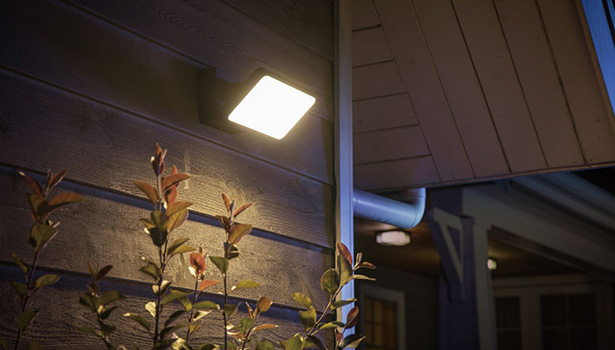
The Difference Between Watts and Lumens
Watts measure the rate at which a light bulb consumes electrical energy, i.e., electrical power; lumens measure the actual brightness produced by a light source and are not directly related to the electrical power consumed. When selecting outdoor lighting fixtures, lumens is a more practical unit that can help us accurately select products that meet our lighting needs without being misled by the energy consumption of the fixtures. The following table clearly shows the difference between the two.
|
Unit of Measurement |
Measured Content |
Relationship with Lighting Effect |
|
Watt |
The electric power consumed by the bulb |
A high power does not necessarily mean a bright light. |
|
Lumen |
The actual brightness generated by the light source |
The higher the value, the brighter the light. |
In short, the difference between watts and lumens is as follows: watts measure the amount of electrical power consumed by a light bulb, while lumens measure the actual brightness, independent of the amount of electrical power required. Lumens are a more valuable measurement than watts when choosing outdoor lighting.
Lumen Requirements for Different Outdoor Lighting
Path Lighting
Pathway lighting is arranged along the pathway to not only guide, but also enhance the aesthetics of the landscape. Its value lies in its ability to effectively “guide”people along the path. Typically, path lights range from 100 to 200 lumens, which is equivalent to a 1 - 2 watt LED light.
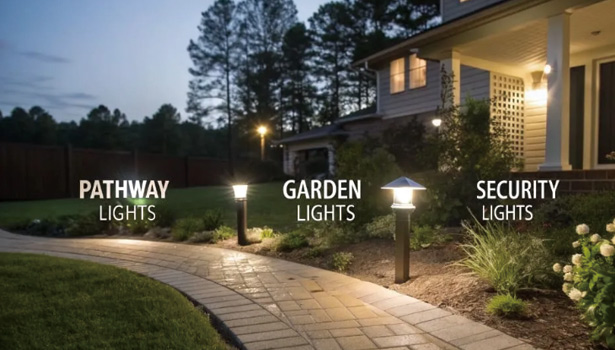
Step Lights
The primary purpose of a step light is to provide safety lighting for steps to prevent accidents when walking up and down steps. They generally range from 12 to 100 lumens.
Floodlights
Floodlights are used to illuminate nearby areas such as around plants, facility grounds, etc. They are also commonly used for gates, outdoor sidewalk lighting, and billboard lighting. Because floodlights require concentrated lighting, solar flood lights require more lumens than garden lights. They range from 700 to 1,300 lumens, with larger commercial solar LED floodlights having a maximum output of 14,000 lumens.
Motion Sensor Lights
Motion sensor lights play an important role in safety and security, quickly illuminating the surrounding area when they detect an approaching person. These lights typically range from 300 to 700 lumens.
Pond / Pool Lights
Pond or pool lights can add a unique touch to a water feature, creating an inviting atmosphere. They typically range from 200 to 400 lumens.
Rigid Landscape Lights (wall mounted)
These lights are primarily used to highlight architectural features such as textures or decorations on walls. Their lumen range is between 50 and 185 lumens.
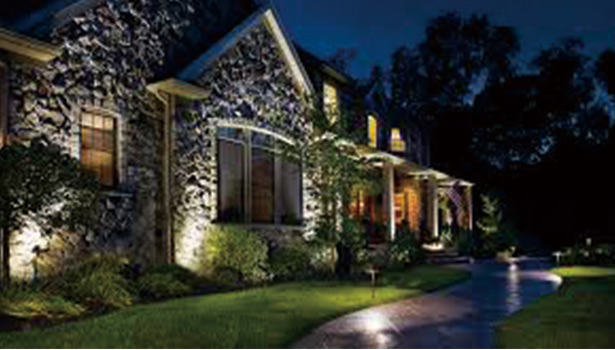
Landscape Lighting
Landscape lighting is versatile, highlighting plants as well as creating a warm and cozy atmosphere. Smaller garden lights may have a lumen output of 100 to 300 lumens, while larger garden lights can have a brightness output of 600 to 1,800 lumens. When used as accent lighting in gardens or patios, the lumen count may be as low as 50 lumens.
|
Lighting Type |
Lumen Range |
Main Purposes |
|
Path Lighting |
100 - 200 lumens |
Guide the road and enhance the aesthetic of the landscape |
|
Step Lights |
12 - 100 lumens |
Ensure safety when going up and down steps |
|
Floodlights |
700 - 1300 lumens (up to 14,000 lumens for large - scale commercial use) |
Illuminate large - area regions |
|
Motion - sensor Lights |
300 - 700 lumens |
Ensure safety and facilitate nighttime activities |
|
Pond / Pool Lights |
200 - 400 lumens |
Create an atmosphere for water landscapes |
|
Hardscape Lights |
50 - 185 lumens |
Highlight the architectural features |
|
Small Landscape Lighting |
100 - 300 lumens |
Provide local lighting and create an atmosphere |
|
Large Landscape Lighting |
600 - 1,800 lumens |
Illuminate large - area landscapes |
|
Focused Landscape Lighting |
50 lumens |
Highlight specific landscape elements |
How many lumens do you need for all in one solar street light?
Advantages and Development of Solar Street Lights
With the improvement of environmental awareness and energy technology advancement, solar street lights are becoming more and more popular as green and energy-saving lighting solutions. Compared with traditional street lights, one-piece solar street lights have obvious advantages. Working with the right solar street light manufacturer, users can easily replace their existing street lights with solar street lights. These solar street lights can last up to 30 years with minimal maintenance and operating costs, greatly reducing long-term costs.
LED Light Source vs. Lumens
LED light source has become the mainstream of solar street light because of its high efficiency and energy saving. As the third generation light source, LED is more energy efficient than traditional light source under the same brightness. When measuring the brightness of LED light sources, lumens (lm) are commonly used as the unit, not watts.This is because brightness is determined by luminous efficiency, i.e. lumens per watt.
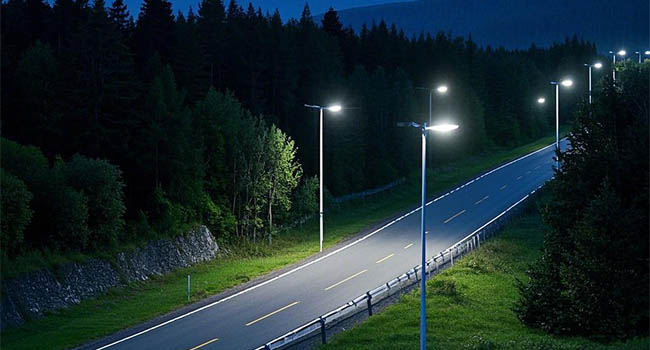
Ordinary lamps and lanterns luminous efficiency is low, only 12 - 24 lumens per watt; Compact fluorescent lamps and lanterns luminous efficiency has been improved, up to 50 - 60 lumens per watt; LED light source per watt can produce more lumens (lm / w), in 2010 the luminous efficiency of LED lamps and lanterns up to 100 - 110 lumens per watt.
By 2020, different types of LED chips on the market luminous efficiency (lm/w) further differentiation, advanced up to 200lm/w or more, part of the 130lm/w or so. Therefore, when calculating the brightness of solar street light, it is more accurate and scientific to use the lumen number to measure, not just look at the LED power.
Misconceptions of solar lamp power labeling
When buying solar street lights, consumers should be alert to the common misconception that the LED power labeling of solar lights is often much higher than the actual power. Take the Amazon store solar flood light for example, the market is commonly labeled 100 watts, 200 watts and 300 watts of solar flood light, the actual 300 watts of solar flood light LED power up to only 15 watts. The actual LED power of the 300-watt solar floodlight is only 15 watts at the most.
As you can see from the power of the solar panel, these products usually have a solar panel power of only 25 to 30 watts. Such a small power of the solar panel, can not support the 300-watt LED long stable lighting, the actual lighting time is often more than an hour. Therefore, consumers buy solar lights, can not just look at the power labeling to determine the brightness and performance of the lamps and lanterns, to focus on the actual lumen output.
Solar street light lumens considerations
In addition to luminous efficiency and power issues, there are other key factors when determining the number of lumens for an integrated solar street light. The number of lumens required per radius of illumination and the height at which the light is installed are important.
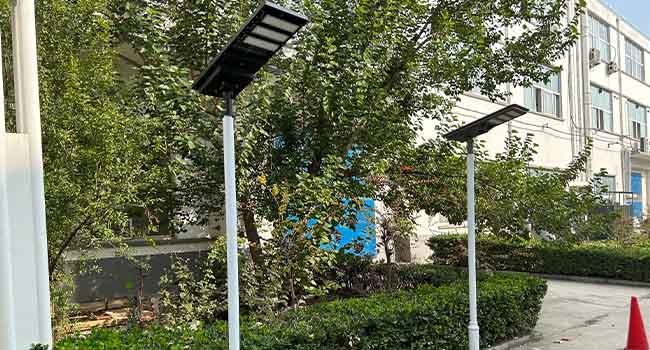
For example, if the light is installed at a height of 8 meters and has to illuminate a 20-meter radius area, the number of lumens has to be calculated accurately according to the optical principle and lighting requirements. Generally speaking, the higher the installation height, the higher the number of lumens required to cover the same area. Because there will be loss in the light propagation process, the height increases, the light dispersion range becomes larger, in order to ensure that the ground has enough brightness, the need for a higher number of lumens of light.
At the same time, the use of the lighting area will also affect the number of lumens to choose. If it is a frequent pedestrian activity in the area, the need for higher brightness to ensure safety; if it is relatively quiet landscape area, the number of lumens can be appropriately reduced to create a soft atmosphere.
4 Factors to Consider When Choosing Outdoor Lighting Lumens
Yard Size
First, you need to measure the size of your yard to determine the number of lumens needed for your outdoor lighting project. A spacious yard will require more lumens for adequate lighting, while a smaller yard will require fewer lumens. Also, keep an eye on the shape of the yard and any obstacles that may block the new outdoor lighting system.
Purpose of the Lighting
Are you trying to create a cozy atmosphere or a safe space? The number of lumens needed will vary depending on the purpose of the lighting. Security lighting with motion detectors requires more lumens for a bright illumination. A cozy deck, on the other hand, may only need a few strings of small twinkling lights.

Style of the house
Naturally, you won't want to flood your outdoor sitting area with bright light. But you definitely want the lighting to match the style of the house. If you own a modern design townhome, you may prefer brighter lighting than a secluded cabin in the woods. Make sure you choose outdoor lighting fixtures that match the style of your house to create a harmonious visual effect.
Existing Lighting
The existing lighting situation can help you decide whether to increase or decrease the use of lumens. You must know the number of lumens produced by the current lighting to achieve your desired level of illumination. Moreover, the old lighting can provide you with the best reference for choosing the brightness, color and color temperature of the new lighting.
How to choose the right lumens for your outdoor lighting in 3 steps
Step 1: Location, function and type
You can illuminate your entire yard with more lumens or provide soft lighting for your driveway with dimmer lights. Manufacturers have designed various types of outdoor fixtures with a wide range of lumen outputs. When choosing the right bulbs for your yard, consider:
-Location: different locations have different lighting needs, such as driveways, backyards, etc.
-Function: whether it is for lighting, decoration or safety and security.
-Type of lighting fixture: lumen output varies by type of fixture.
Step 2: Understanding Lumens and Their Impact on Brightness
Using lumens as a unit of measurement, you can determine the brightness of a light source. The more lumens a light bulb puts out, the brighter it will be. Think of lumens as the amount of light “coming out”of a light source; the more, the brighter.
Step 3: Calculate the number of lumens needed for different outdoor lighting fixtures
Calculating the number of lumens needed to achieve the desired brightness depends on the type of lighting fixture you purchase. Multiply the area of your outdoor space by the recommended lux value. For example, if you're redecorating a 328-square-foot yard with a required lighting level of 20 lux, then 328 square feet × 20 lux = 6,560 lumens. You can then calculate the lumens per square foot for outdoor lighting by dividing 6,560 by 328, which results in 20 lumens per square foot.
Choosing the right number of lumens is critical to creating the ideal outdoor lighting. From understanding the concept of lumens, to considering the needs of different types of outdoor lighting, to incorporating factors such as yard size, lighting purpose, house style, and existing lighting, and finally calculating the lumens needed through the right steps, each component is closely intertwined. Hopefully, with this article, you'll be able to choose the best lighting lumens for your outdoor space to make your outdoor area both beautiful and functional, as well as safe.

